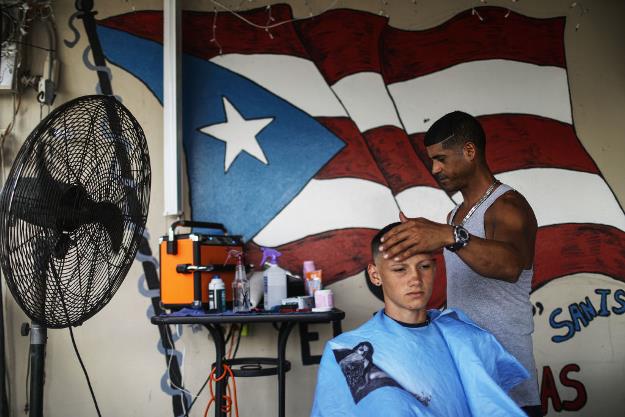The third week of September was the longest of my life. Hurricane Maria hit Puerto Rico on Sept. 20 and almost immediately plunged the island into darkness – downing telephone lines, flooding roads and shutting down the power grid. My grandparents were home in Patillas, on Puerto Rico’s southeastern coast, when Maria made landfall. Days ticked by without word.
That my grandparents could be so thoroughly cut off was not a surprise. Even before Hurricane Maria – and before Governor Ricardo Rosselló’s announcement that parts of the grid could remain offline for a year – Puerto Ricans had grown accustomed to blackouts. Indeed, the grid’s vulnerabilities were laid bare more than a year ago, when a fire at a power plant led to a near island-wide blackout for several days. The need for renovation is not news.
“The energy grid in Puerto Rico has been living a non-Hurricane storm for the past five years,” said David Lewis, who manages Manchester Trade’s energy practice.
But while the grid’s inadequacies have long been clear, fixing them has seldom seemed a priority.
Part of the reason is Puerto Rico’s $74 billion debt, of which its beleaguered electric utility – Puerto Rico Electric Power Authority, or PREPA – is responsible for approximately $9 billion. PREPA officials say they need $4 billion to upgrade the system, but it’s unclear where that money will come from. Even before Maria, the Puerto Rican government didn’t have cash to invest, and the utility went bankrupt in July; it has been fighting to restructure its debt for years.
The lack of financing has meant chronic underfunding for maintenance and capital improvement on antiquated infrastructure. But PREPA’s problems extend beyond its debt load. The utility has also lost 30 percent of its workforce – much of it skilled labor – since 2012, either through retirement, or through brain drain to the mainland. And because the utility is state-controlled, its regulatory framework is often too bureaucratic and convoluted for innovative approaches and private investment.
“The whole regulatory regime is anachronistic,” said Lewis. “There’s no room for renewables, there’s no room for companies or homes producing their own energy like solar and selling it back to the grid.”
The utility also relies heavily on costly imported fuel oil to generate electricity – meaning its customers pay several times more than customers on the mainland, for less reliable service.
The Jones Act, an outdated maritime law that requires all goods shipped between U.S. ports to come on American-made and -flagged vessels with a majority American crew, further complicates the island’s energy options. There aren’t any ships capable of transporting natural gas that meet Jones Act requirements.
All these challenges were made worse by a tepid federal response to the crisis. Before the storm, President Donald Trump approved a state of emergency for Puerto Rico and later declared it a disaster area. But it took days for a sufficient number of relief workers to arrive. FEMA now says that there are 10,000 federal workers on the ground, but more than two weeks after the storm Congress has yet to focus on a relief bill for the island. Trump eventually waived the Jones Act for Puerto Rico to allow international relief to come directly to the island, but the waiver will only last until Oct. 8.
The humanitarian crises the island still faces are hard to overstate. Hospitals are running on generators, the elderly are sleeping on tile floors to try to stay cool in the heat, and water pumps that rely on electricity to bring potable water to many parts of the island are offline. Neighbors and local leaders are doing their best, but there are not enough generators, water, food, or ways to transport them to reach the more than 3.4 million people on the island.
Like many Puerto Ricans off the island, in the days that followed the hurricane I called local government hotlines, posted on social media, and called anyone I could think of: “Have you heard anything from Patillas? Have you seen my grandparents?” In the end, I was lucky. After seven days, I finally received word that my grandparents were OK. Without power or phones, and with damage to their home – but OK. But for them and many others, rebuilding Puerto Rico – a task whose urgency far preceded the hurricane – lies ahead.
There are some steps that the federal government can take quickly to help that effort. The U.S. Senate can immediately vote on a measure from Senators John McCain (R-Ariz.) and Mike Lee (R-Utah) to grant Puerto Rico a permanent exemption from the Jones Act, which will help reduce costs on needed supplies. A moratorium on the island’s debt repayments, if not all-out debt forgiveness, would also help officials direct funds where they are needed most.
Finally, Congress should pass a relief bill to provide emergency aid and workers, and to rebuild Puerto Rico’s damaged roads, bridges, dams, and, especially, electrical and water infrastructure. Trump, who visited Puerto Rico on Oct. 3 and praised the federal response thus far, signed a $15 billion relief bill within two weeks after Hurricane Harvey hit Houston. It is now more than two weeks since Maria hit Puerto Rico, and we have yet to see a relief bill – or even draft language – surface in either house of Congress. While fundraising efforts of the Puerto Rican diaspora, celebrities, and city and state governments on the mainland are laudable and necessary, it should not be up to them to save lives.
Puerto Rico needs action, not platitudes. It’s time for the federal government to bring the 3.4 million U.S. citizens like my grandparents out of the dark. This is indeed a real catastrophe, and thousands of lives are at stake.
—
García is social media and production editor of Americas Quarterly and policy manager for Americas Society/Council of the Americas. Follow her on Twitter @LeaniGarcia.









